Over the last few seasons, Nancy had been making steady progress in Ligue 2. They managed a 17th place finish in 2017/18 — narrowly avoiding relegation just a season after they were relegated from Ligue 1 — before earning a 14th place finish in 2018/19, a 12th place finish in 2019/20 and an eighth-place finish in 2020/21. Heading into the 2021/22 campaign, it appeared as though Les Chardons could be set to pose a promotion challenge for the first time since that 2016/17 relegation under new boss Daniel Stendel, who’d previously managed Hearts in the Scottish Premiership, Barnsley in the EFL Championship and Hannover in 2. Bundesliga.
However, things quickly went wrong for the Grand Est-based club under Stendel and the German ultimately departed from Nancy after just 10 games in charge — winning none of them and managing to earn just four draws, leaving Nancy in a precarious position at the bottom of Ligue 2 and in search of a new manager to now lead their recovery. Former France international player Benoît Pedretti took the reins as caretaker following Stendel’s departure until earlier this month when 61-year-old Albert Cartier became the third man to sit in the Nancy hot seat this term, now tasked with leading the struggling club away from the relegation zone, a challenge that won’t be an easy one.
At present, Nancy are sat firmly at the bottom of Ligue 2 on 15 points with at least one less game played than the three closest teams to them on the table. While survival isn’t impossible, it’s getting more and more unlikely by the week and if Cartier is to successfully turn things around at Stade Marcel Picot, he’ll need to start getting results ASAP. His tenure did start rather positively, with his side managing a 2-1 win over Bastia-Borgo, but their most recent league game, a 4-0 defeat to title-challenging Toulouse may have given Cartier a harsh but necessary reality check on the task at hand.
So, what has gone wrong for Nancy this season? More than I will be able to discuss in this analysis, unfortunately, though they’ve experienced their fair share of bad luck too. However, this tactical analysis piece and team-focused scout report aims to highlight some of the key areas in which Nancy must improve under Cartier if they’re to manage a late survival push this season. I’ll aim to highlight areas in which their tactics and individual performances/decisions have let them down this season to point out where Cartier needs to focus his efforts most heavily in his new job. All stats and data used for this analysis has come from Wyscout unless otherwise stated.
Final third concerns
To briefly explain Nancy’s style of play and tactics in possession this season, they’ve consistently been a very aggressive team with and without the ball, looking to press and win the ball high up the pitch a lot, while also looking to quickly progress the ball into those areas. Their performances on the ball, in general, haven’t been much of a concern. They’ve been quite a possession-dominant side in Ligue 2 this season, keeping 54.4% of the ball on average (fourth in the league), while they’ve played the sixth-most progressive passes in the league (66.29 per 90) with the ninth-best progressive pass accuracy (74.9%), indicating that their ability to break lines and get the team moving through the thirds hasn’t been particularly poor.
Additionally, when in the final third, they’ve not been particularly poor at setting up goalscoring opportunities via a variety of different skills, with Nancy making the most dribbles of any Ligue 2 side this season (33.7 per 90) with the eighth-best accuracy (52.6%), the seventh-most key passes (2.9 per 90) and generating the sixth-most touches inside the opposition penalty area (14 per 90).
All of this has helped them to generate a decent number of shots (9.99 per 90 — the seventh-most in Ligue 2) but their shot accuracy has often let them down (32.6% — the second-lowest shot accuracy in Ligue 2). Furthermore, they’ve generated the ninth-highest xG in France’s second-tier this term (22.89), and this is a far more respectable number than their actual goals scored, which sits at 16, giving them the second-worst goalscoring record in the league.
This backs up my belief that up until they reach the opposition’s penalty area, their performances in possession aren’t much cause for concern. Their big need in terms of what they’re doing with the ball is focusing on what they do inside the box and finishing more efficiently.
One thing I’d try to focus on to achieve this is decision-making inside the opposition box. Too often, Nancy’s strikers, primarily Mickaël Biron, Andrew Jung and Mamadou Thiam, are taking shots with too much haste and not enough care. There are many examples of poor shot selection and, in turn, poor decision-making inside the opposition box in Nancy’s performances this season.
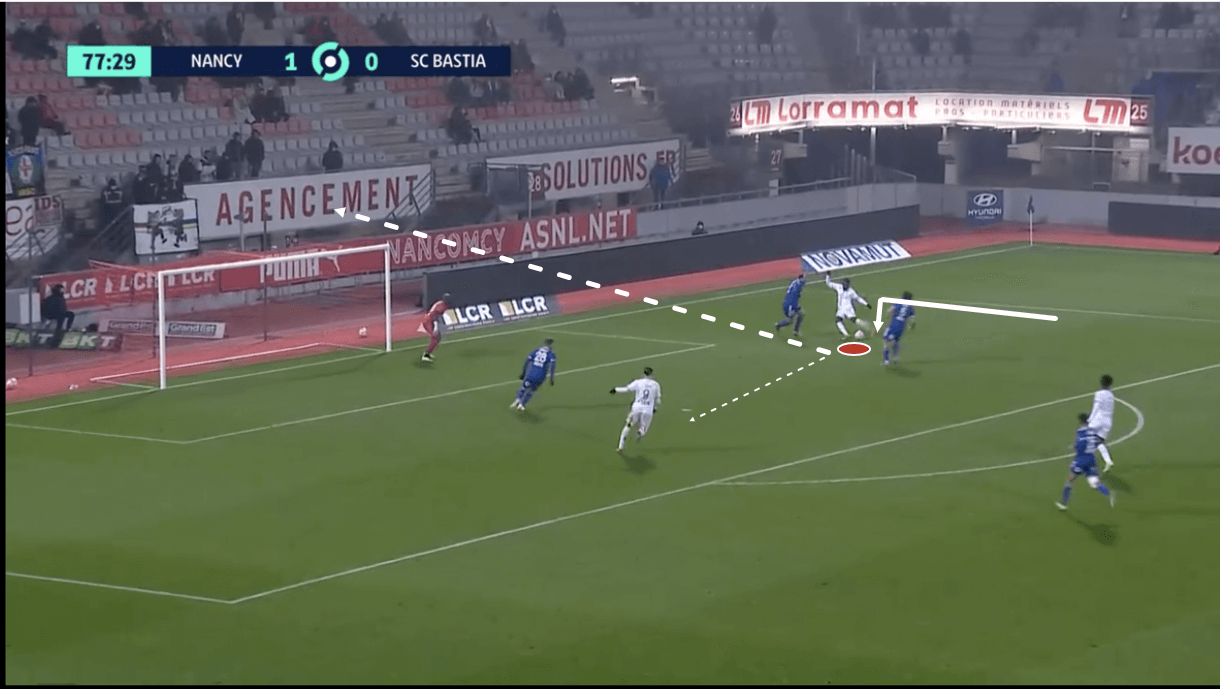
Figure 1 shows an example of this poor decision-making in crucial moments. Here, we see right-forward Biron on the ball inside the penalty area, having just cut in on his weaker left foot. Despite being on his weaker foot here and at a difficult angle from which to score, the attacker takes the shot and, as was likely in this situation, misses the target which leads to this opposition box entry being wasted.
Even more frustrating for Nancy in this particular example is that if Biron had been less hasty here and gotten his head up, he could’ve spotted his teammate, left-forward Jung, in the box giving him a good option to square the ball to. Jung is in a far more favourable shooting position here and has enough separation from the nearest defender to create some space for a shot, should the ball be played to him. However, Nancy’s tendency to snatch at shooting opportunities reared its head here and the opportunity was lost.
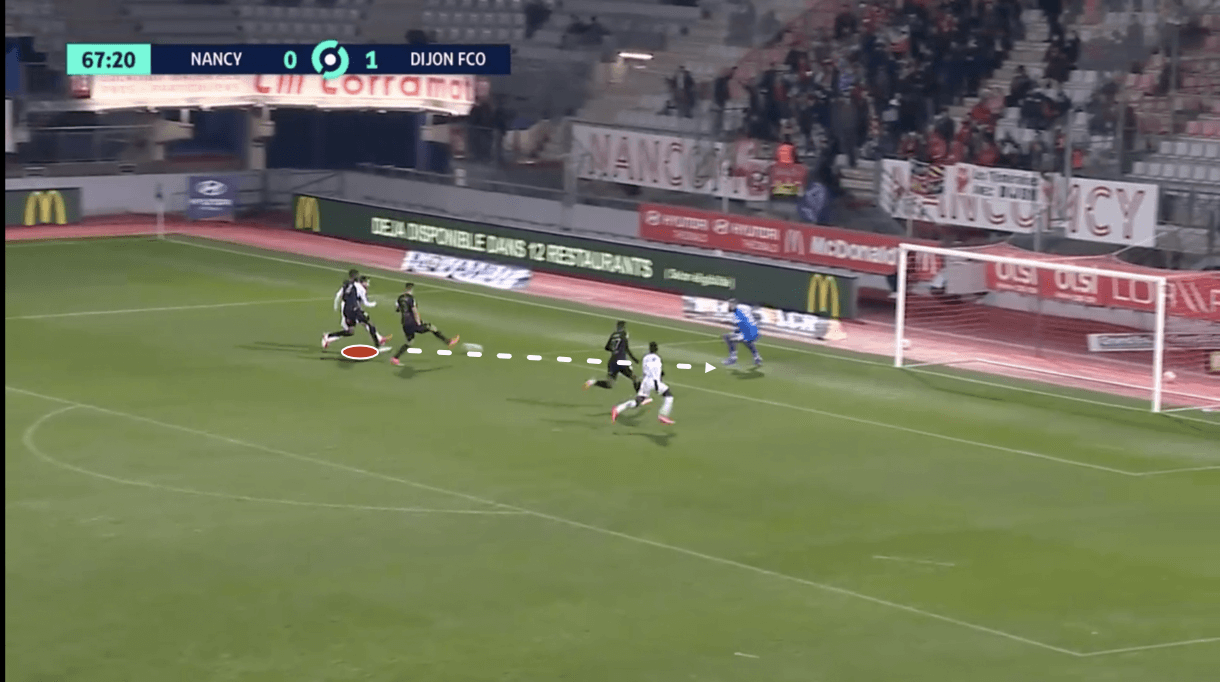
Figure 2 provides another example of this poor decision-making, this time from Andrew Jung on the left. Again, we see the striker shooting from an awkward angle with his weaker left foot here. The outcome is the same — an opportunity missed — as the ball flies straight at the opposition goalkeeper. There was another teammate in the box here, but in fairness, the opposition are defending against that pass across goal quite well. Still, though, you’d have to ask yourself: is shooting from this angle on your weaker foot really the best option here? Again, I feel this is an example of haste in Nancy’s performance in the final third and an area in which they can look to improve.
During the summer, Jung was a highly sought-after player and I wrote about his role at Quevilly-Rouen Métropole last season, along with what his new club — which eventually turned out to be Nancy — must do to get the best out of him. I’m not 100% convinced that Nancy have done that this season. Firstly, Jung was a right-forward in a two-man partnership last season and I think that perhaps putting him back on the right could be beneficial. Alternatively, I think Jung is more than capable of playing as a lone striker if necessary/desirable. The main thing, though, is I think if you have Jung, you want him to be your focal point in the centre of attack. You don’t necessarily want him dropping deep a lot and you definitely don’t want him trying to carry the ball past defenders or into better shooting positions, which figure 2 shows an example of. You want him to be less involved outside the box and mainly contributing to chance creation via his off-the-ball movement to find/create space for himself. He’s also good with his back to goal and is happy to play the role of a hold-up forward.
He’s not necessarily the guy you want dribbling from wider areas and looking to cut inside, as he’s sometimes had to do for Nancy this season. It can lead to shots from awkward angles as we see here, because Jung’s 1v1 dribbling ability isn’t his area of strength. In my article from the summer, which can also be read at Total Football Analysis here: Andrew Jung: One of Ligue 2’s most wanted – how his potential new club can get the best from him – scout report, I likened him to a Ligue 2 version of Serie A’s AC Milan forward Olivier Giroud and I think if you treat him as such, you will get a top-quality player who’s capable of spearheading a late survival push. However, he’s a player who, if used incorrectly, has big weaknesses that can be exposed, while his great strengths are hidden.
Central midfield overloads
With that said, again, Nancy’s main area of concern isn’t actually in their on-the-ball game — though the aforementioned issue is still a big one — rather, it’s in their off-the-ball, defensive performance. This season, Nancy have faced the sixth-most shots (9.94 per 90) in Ligue 2, while they’ve got the fourth-highest xGA (27.49) of any Ligue 2 side as well. Neither of those numbers do much to fill you with confidence about their defensive performance in general, and it would appear as though they’ve defended quite poorly during the 2021/22 campaign.
Even more worrying, though, is the fact that they’ve conceded significantly more than expected, with 38 actual goals against to their name. This gives them the worst defensive record in terms of goals in France’s second-tier. Evidently, this level of defensive underperformance is going to have a big impact on league position, but even ignoring that and looking solely at xGA, we can see that Nancy haven’t defended well enough this season and while they’ve had their fair share of bad luck, they’ve also not helped themselves much.
They’ve managed to generate this poor defensive record despite the fact they’ve performed well in defensive duels (70.74 per 90, the third-most in Ligue 2, with 63.1% defensive duel success, the second-most in Ligue 2), while effectively pressing very aggressively (7.52 PPDA — the second-lowest in Ligue 2, indicating that Nancy have had the second-most aggressive press in the league this term).
Nancy’s pressing has been very effective this season; they love to defend aggressively while the opposition build out from the back, with the central midfielders marking their opposite numbers very tight in this phase while the wingers orientate themselves to position while retaining access to the near full-back. Meanwhile, the centre-forwards either apply out-to-in pressure to prevent centre-backs from playing out to the full-backs and driving them backwards or cut off the passing lane to the other centre-back to force the opposition to play in a smaller area. In the case of the latter, Nancy will leave the pass out to the full-back open, to draw the opposition into that pass before increasing their pressure out wide while using the sideline to their advantage.
These are a couple of their pressing triggers but in general, Nancy are extremely aggressive and operate with a high line of engagement, so any forward passes from the centre-back will also lead to plenty of pressure on the receiver and the nearest passing options to them. It’s common to see Nancy engaging the opposition right on the edge of their own third and even inside their own third. This pressing has been effective for Nancy this season and it’s probably the biggest factor in why they’ve had so much possession in 2021/22, they simply don’t allow their opponents time on the ball.
Moving back into deeper areas, Nancy are also, generally, very effective, with their midfield continuing to mark zonally but with the central midfielders continuing to concern themselves with movement from nearby opposition players. This can result in those midfielders being pulled away from their base position and, ultimately, manipulated by the opposition. We’ve seen this on multiple occasions of late, with this being the main reason why Toulouse dominated Nancy so much in their recent league clash.
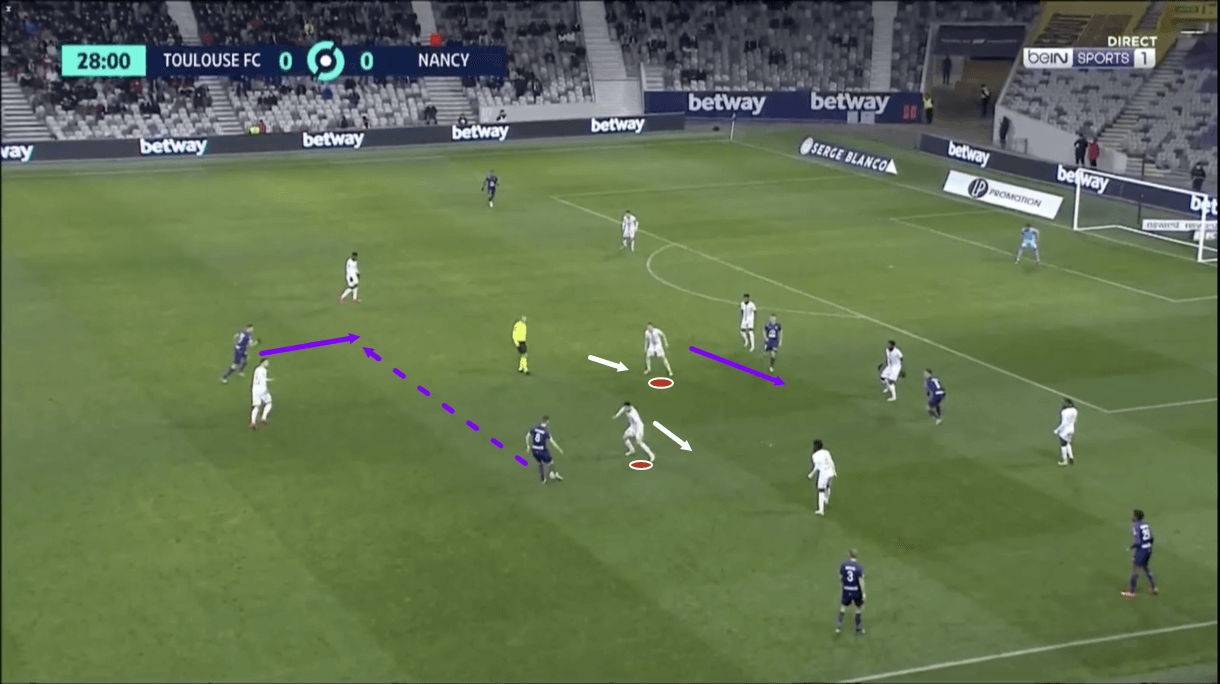
Figures 3-4 show us how Toulouse scored their first goal in this game. Here, we see Nancy playing with two banks of four behind one attacker, having received a red card earlier in the game. Granted, the red card will make defending versus a strong Toulouse side significantly harder, but as you’ll see from this example, they still could’ve done more to at least make life more difficult for Toulouse here.
Just before figure 3, the opposition’s left central midfielder ran to the right, dragging Nancy’s right central midfielder with him, as is marked on the image above. This bit of manipulation from Toulouse’s midfield runner, and the failure of Nancy’s right-winger to come across and protect the central space, created an opening for the team to effectively exploit the newly-found space in midfield, which is exactly what happens. As play moves on, we see Toulouse’s right central midfielder on the ball here play the ball into his teammate exploiting the space vacated by Nancy’s right central midfielder.
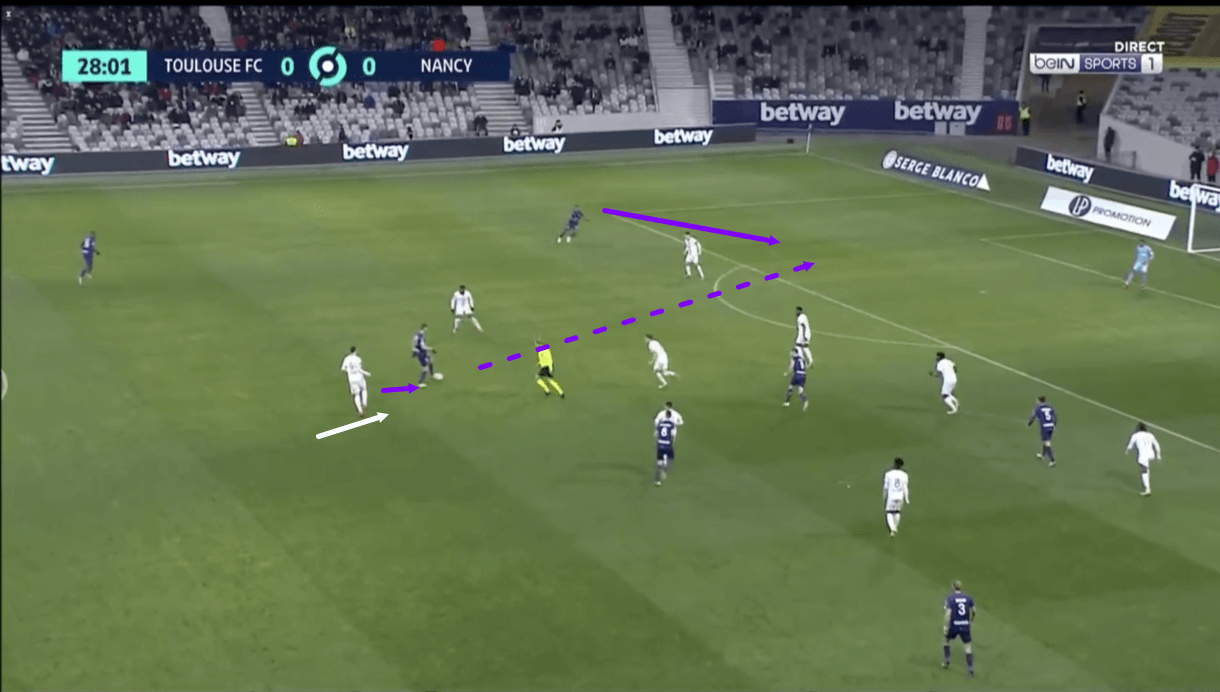
Nancy’s centre-forward could’ve played an important role here by tracking the runner who was closest to him and preventing him from exploiting this space, while he at least could’ve made a better attempt at getting back and defending once the pass was played. However, as figure 4 shows, he didn’t do either and the opposition midfielder had the time and space to create from central midfield, where he picks out a run in behind Nancy’s right-back from his left-winger.
The right-back could also have done better here by scanning to be more aware of this attacker’s run and positioning himself better to block the through ball. However, I think the main issue here is Nancy’s failure to protect the centre well enough once the right central midfielder’s positioning was manipulated. For me, the centre-forward has to offer more in terms of tracking back in this instance, while the right-winger also needs to be coming across more to protect the space between him and the right central midfielder.
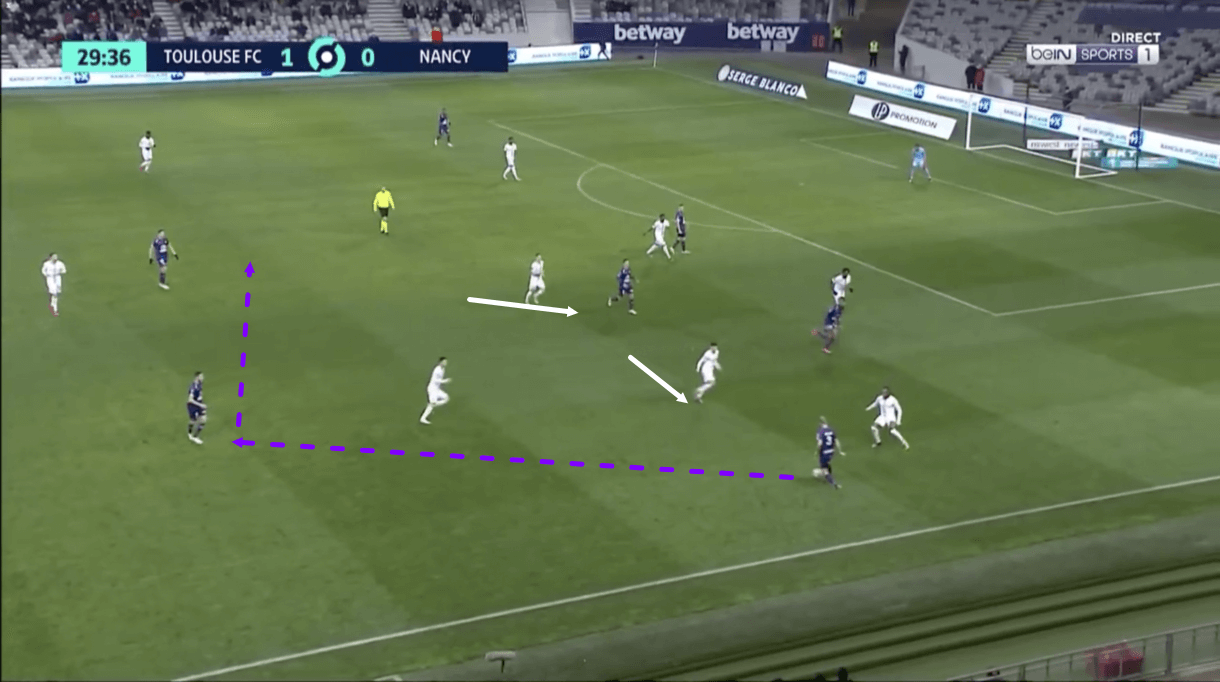
Figure 5 shows another example from this same game, which is eerily similar to the previous one. Here, we once again see Toulouse building via their right-wing, with a run from their left central midfielder dragging Nancy’s right central midfielder away from his base position. And yet again, this creates the opportunity for Toulouse to break through central midfield by exploiting the space he’s vacated. Similar to the previous example, the centre-forward doesn’t do enough in terms of tracking the player’s run or making an effort to get back once the pass has been played, while the right-winger is not coming across with his midfield partners to keep the chain intact, allowing a gap to open in the first place for the opposition to exploit. Due to this, the opposition midfielder is given far too much time and space to just create from a dangerous central position, leading to another defence-splitting through ball.
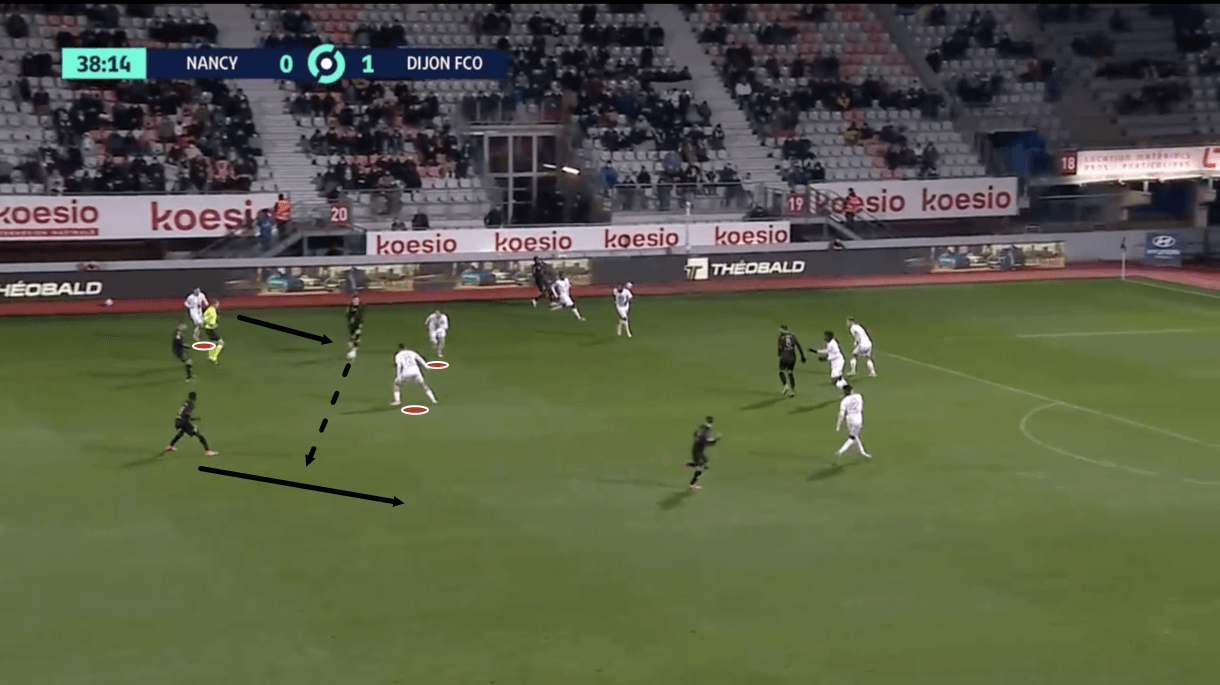
Figure 6 shows a similar example from a different game, this time with Nancy defending in a 5-3-2 shape and a system that’s heavily focused on congesting the space around the ball and remaining heavily compact. Here, their opponents are building their attack via the left wing and Nancy are, as a result, drawn to this side to congest the space around the ball. However, the left central midfielder fails to block the pass across him into central midfield, allowing the opposition to escape this press and break through midfield on the opposite side where there’s far more space and, at this moment, no Nancy shirts.
Again, this pass allows the opposition to cut through Nancy’s low-block far too easily via a simple but intelligent lateral pass and some simple but intelligent movement. This kind of pass has ripped Nancy apart too often recently. Yes, when defending high, Les Chardons are a very effective pressing unit but in deeper areas, they try to remain aggressive but allow too much space to open for the opposition to target via some patient and observant passing and movement. As a result, greater central protection in deep areas and more disciplined, basic defending, such as the winger coming across with his midfield partners to keep the chain intact, is a requirement for Nancy’s survival hopes in the second half of the season. They can’t afford to miss basics like this in their relegation battle.
Aerial duels and set-pieces
For the final section of analysis in this scout report, I’m going to focus on Nancy’s defensive aerial duels, with a slight focus on defensive set-pieces too. Cartier’s new side have engaged in the fourth-most aerial duels (42.7 per 90) of any Ligue 2 side this season but their aerial duel success rate (44.5%) is the sixth-worst in the league. Additionally, Nancy have conceded 11 headed goals this season, which is the most of any Ligue 2 side by at least three. With headers typically being assigned a lower xG value than regular shots, this is likely part of what’s contributed to the big gap between their xGA and actual goals conceded.
Furthermore, Nancy have been bad at defending from set-pieces this term, with a lot of their conceded goals coming from set-pieces. I’ll touch on one specific issue at set-pieces that I’ve noticed in this section of analysis, but an entire in-depth set-piece analysis piece would be an interesting one for this team because of their alarming deficiency in this area. It’s definitely something the new manager and his coaching staff should be prioritising for the rest of this season.
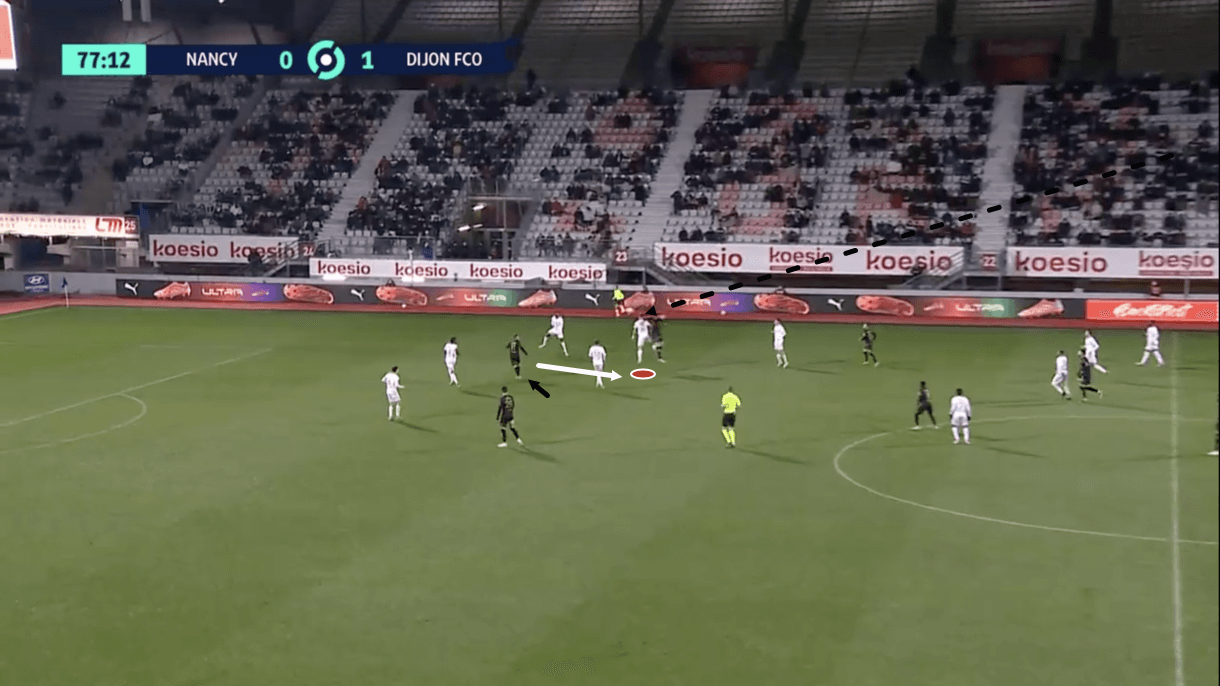
As was the case in figure 7, Nancy’s centre-backs are often dragged out of the backline to contest aerial duels from the opposition’s long goal-kick. The centre-backs haven’t been reliable enough in these situations this season, however. In figure 7, the centre-back doesn’t get tight enough to or physical enough with the opposition attacker as they jump, meaning they fail to stifle the jump at all and they could rise above them. The attacker didn’t actually win the aerial duel here, but his jump was high enough to have blocked the Nancy centre-back’s view, while the centre-back also didn’t jump in the best way to attack the ball and send it back upfield, rather turned while jumping and essentially allowed the ball to glide off him instead of attacking it.
This led to the ball bouncing on into the path of the opposition attacker running in behind to attack the space left open by the centre-back. Yes, the finish at the end of this move — a rocket from outside the box — is an excellent finish that the ‘keeper could do little about and an example of the bad luck Nancy have had this term. However, I still feel the opposition could’ve been prevented from progressing to that point had the aerial duel been dealt with better.
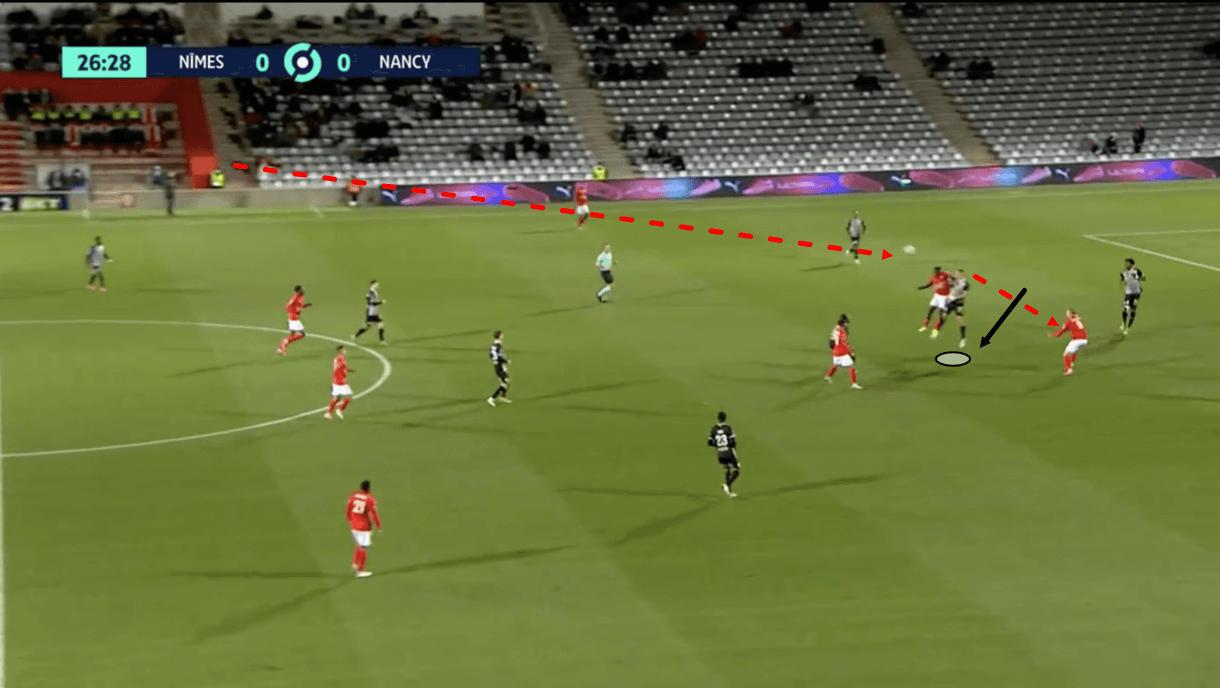
We see a very similar example from a different game in figure 8. Here, the right centre-back has been pulled out to contest the aerial duel but, again, he fails to get tight enough to/physical enough with the attacker to really stifle his jump at all, allowing him to rise above the defender and knock the ball on into the path of the attacker running in behind.
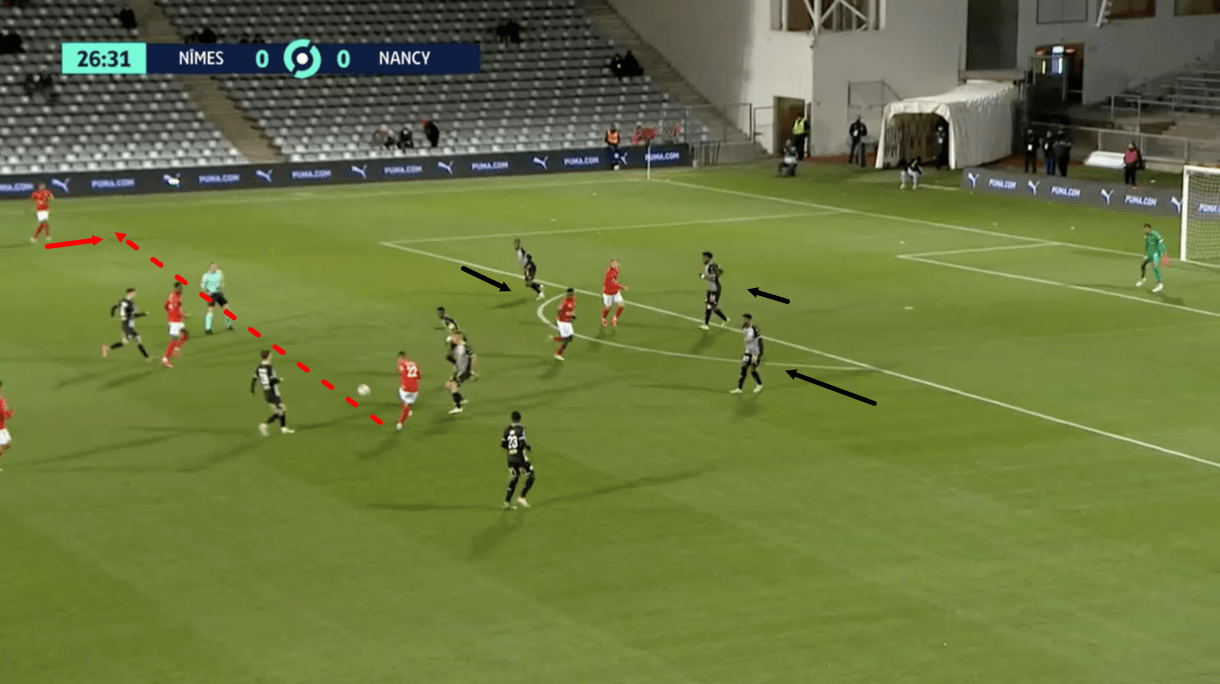
Here, instead of going on himself after picking up the ball, the runner intelligently plays the ball out to the left-sided wide man who we see in acres of space in figure 9. It’s noteworthy that when one of these centre-backs comes out from the backline to contest the aerial duel, the rest of the backline comes together centrally to protect the space he’s vacated and ensure the central zone is not vulnerable should the aerial duel be lost. While they successfully achieved that in figure 9, this also has a weakness in that the wings are naturally, then, left open and the full-backs have a lot of ground to cover to close down opposition wide men should the ball be played out to them, as we see an example of in figure 9.
With Nancy’s poor defensive record in the air this season, they need to avoid giving opposition crossers so much time and space on the wings as they did here. Unfortunately, it is necessary to protect the centre, first and foremost, but this again highlights how failure in aerial duels can and has hurt Nancy this term. Additionally, perhaps more should be asked of the winger here, in terms of tracking back to offer some support to his full-back on this occasion. If we go back to figure 8, we can see that the right-winger is the furthest-forward midfielder here, with a lot of space open between him and the right-back. With this space eventually getting exploited as the right-back moved further infield, perhaps it’s fair enough to say the winger should’ve been more active in tracking back in this example.
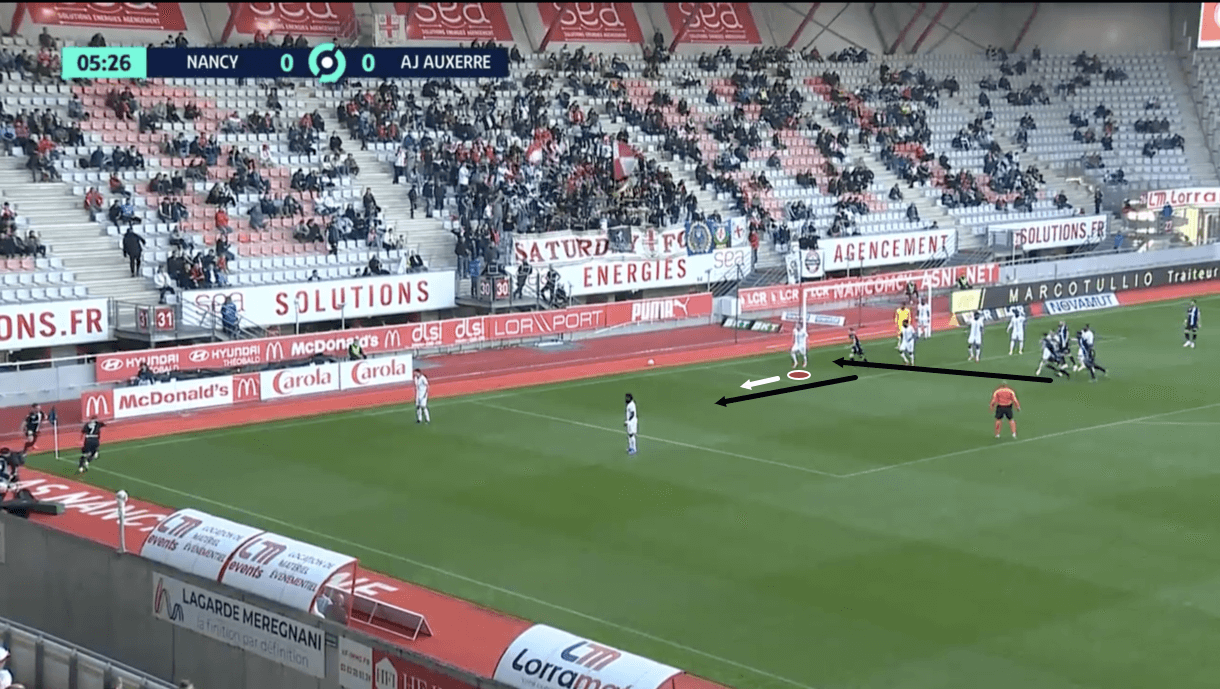
Moving onto set-pieces, again, I think a full, detailed set-piece analysis on Nancy would be well worthwhile to thoroughly examine their poor performance in this area, but one particular trend I’ve noticed in their defensive set-pieces is a tendency for the player marking their near-post and/or the player marking the front of their six-yard box to be dragged away, creating space for another attacker to swoop in behind and get onto the end of either the initial cross or a second ball inside the box.
Take figure 10, for example. Here, we see an example of Nancy’s typical defensive corner set-up, with five men around the goal — one zonally marking the back post, one zonally marking the front post and three zonally marking the six-yard box (one at the front, middle and back). Meanwhile, they have two players on the edge of the box near the corner-taker, one on the edge of the front of the box just out of shot here and two players focused on guarding opposition runners outside the six-yard box.
Here, one opposition runner near the front post is about to move and drag the player marking the front post away from his position. As he does so, the opposition player outside the six-yard box and nearest to the corner-taker bypasses the Nancy defender guarding his run and basically infiltrates the space that’s been opened at the front post by his teammate’s intelligent and unselfish run.
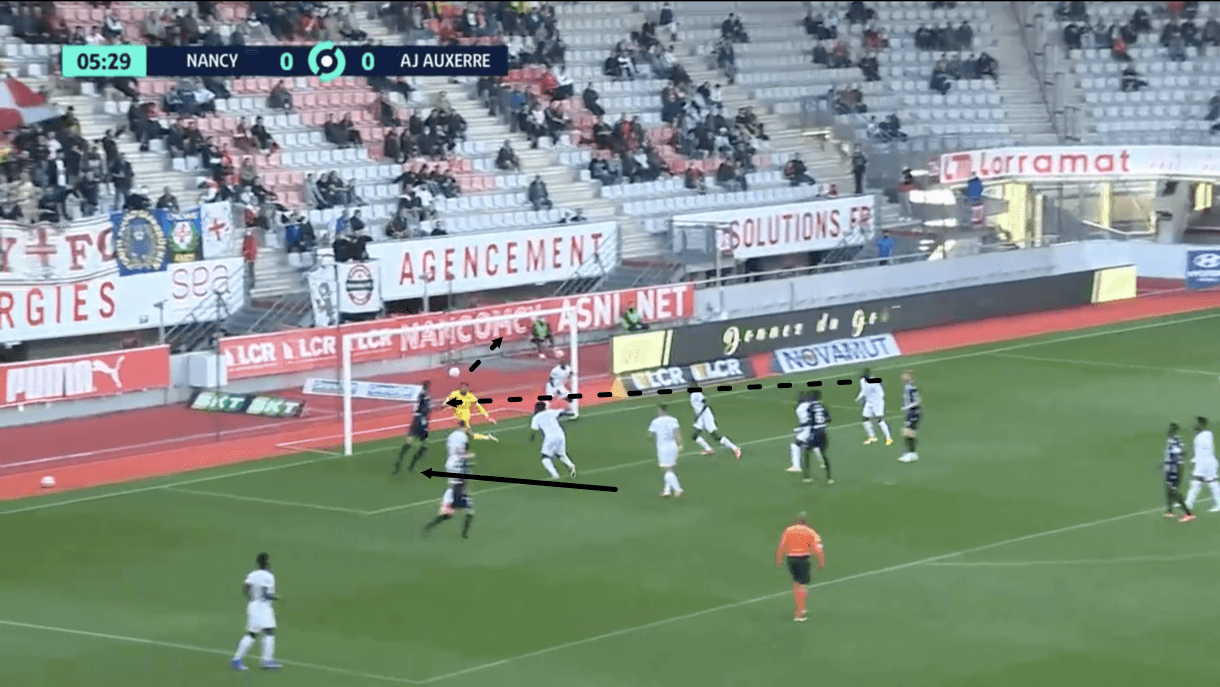
As the set-piece progresses into figure 11, we see that the new opposition player at the front post ends up on the receiving end of a headed pass/shot from a teammate who won the initial aerial duel resulting from the corner. From here, the attacker has a free header inside the six-yard box that he can easily tuck away.
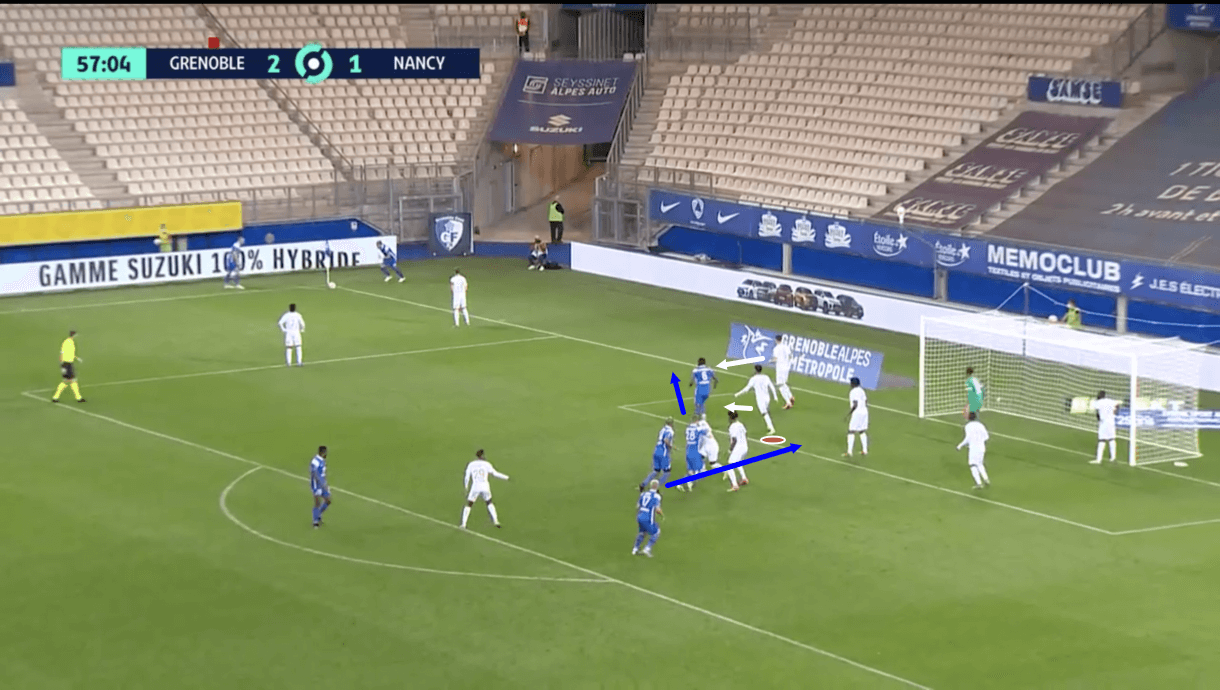
We see another example of this from another game in figure 12. We see Nancy operating with the same set-up here, while the opposition have a corner from the left again. Here, the opposition runner nearest to the player at the front of the six-yard box makes a forward movement that not only drags his marker at the front of the six-yard box forward a couple of steps, but also ends up dragging the player marking the front post forward as he ends up driving into his zone too.
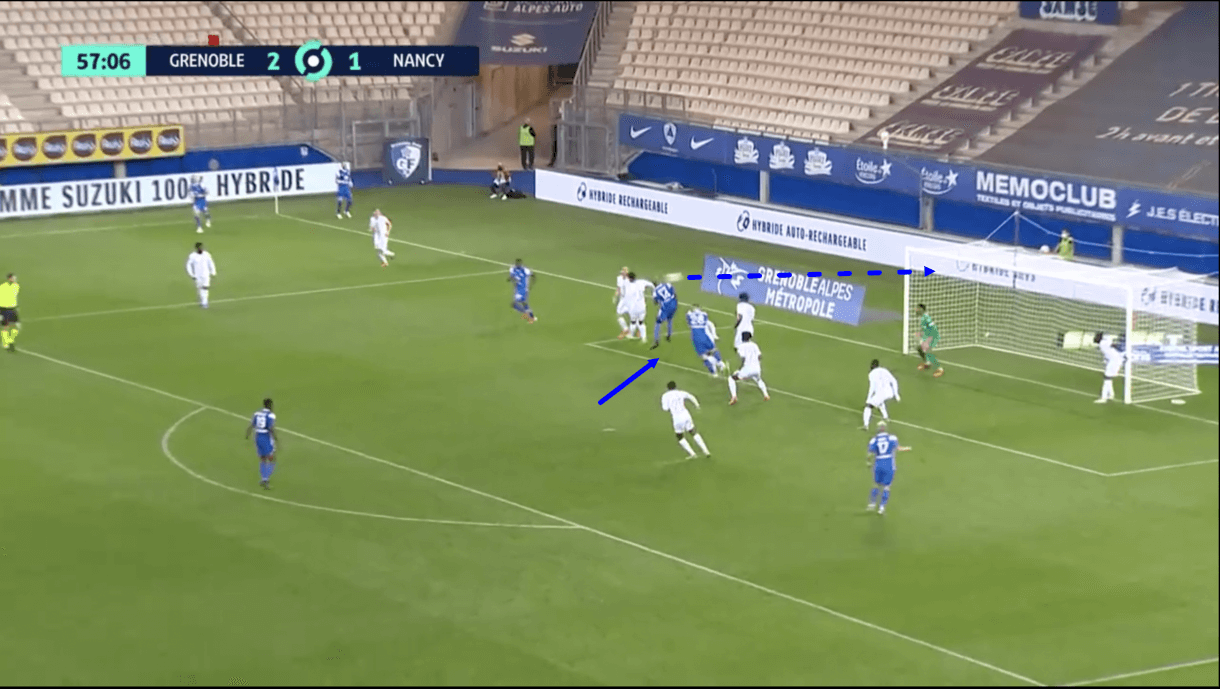
Again, this creates space for one of the runners from deep to attack and as he breaks past the defender guarding him initially, we see that he actually ends up behind the Nancy defenders marking the front post and the front of the six-yard box, from where he can take a free headed shot at goal, that results in a goal for Grenoble.
Given how much they’ve conceded from set-pieces this term, defending them is undoubtedly top of Cartier’s priority list right now and hopefully, this analysis has shown an example of one area of concern for Nancy within defensive set-pieces.
Conclusion
To conclude this tactical analysis, I hope some of the main areas in which Nancy need quick, vast improvement have been made clear via this scout report. Their main area of focus on the ball needs to be their work in the final third, particularly what they do inside the box, while in terms of their defensive performances, I hope it’s clear that doing a better job of working to avoid central overloads, performing better in aerial duels and being better-organised at defensive set-pieces are necessary if they are to stand a chance in their relegation battle under new boss Cartier, who clearly has a tough task on his hands.





Comments